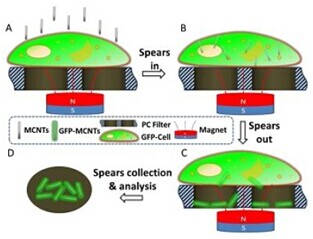Researchers Employ Magnetized Carbon Nanotubes to Extract Biomolecules from Live Cells
A. An external magnetic field drives magnetic carbon nanotubes toward a cell cultured on a polycarbonate filter. To indicate the molecular extraction, the cell is transfected for GFP overexpression beforehand. B. MCNTs spear into the cell under magnetic force. C. MCNTs spear through and out of the cell and extract GFP. GFP-carrying spears are collected in the pores of a polycarbonate filter. D. GFP representing the intracellular signal molecules can be used for analysis of individual pores. Credit: University of Houston
The researchers used magnetized carbon nanotubes to extract biomolecules from live cells, allowing them to retrieve molecular information without killing the individual cells. A description of the work appears this week in the Proceedings of the National Academy of Sciences.
Most current methods of identifying intracellular information result in the death of the individual cells, making it impossible to continue to gain information and assess change over time, said Zhifeng Ren, M.D. Anderson Chair professor of physics and principal investigator at the Center for Superconductivity at UH and lead author of the paper. The work was a collaboration between Ren lab and that of Paul Chu, T.L.L. Temple Chair of Science and founding director of the Texas Center for Superconductivity.
Other key researchers on the project included Xiaoliu Zhang, a cancer researcher with the UH Center for Nuclear Receptors and Cell Signaling, and Dong Cai, assistant professor of physics.
Chu, a co-author of the paper, said the new technique will allow researchers to draw fundamental information from a single cell.
"Now, (most) techniques break up many cells to extract the material inside the cells, so what you get is the average over many cells," he said. "The individual cells may be different, but you cannot see exactly how they function."
The researchers said the steps outlined in the paper offer proof of concept. Ren said the next step "will be more study of the biological and chemical processes of the cell, more analysis."
The initial results hold promise for biomedicine, he said. "This shows how nanoscience and nanoengineering can help the medical field."
Cai said the new method will be helpful for cancer drug screening and carcinogenesis study, as well as for studies that allow researchers to obtain information from single cells, replacing previous sampling methods that average out cellular diversity and obscure the specificity of the biomarker profiles.
In the paper, the researchers explain their rationale for the work – most methods for extracting molecular information result in cell death, and those that do spare the cell carry special challenges, including limited efficiency.
This method is relatively straightforward, requiring the use of magnetized carbon nanotubes as the transporter and a polycarbonate filter as a collector, they report. Cells from a human embryonic kidney cancer cell line were used for the experiment.
The work builds on a 2005 paper published by Ren group in Nature Methods, which established that magnetized carbon nanotubes can deliver molecular payloads into cells. The current research takes that one step further to move molecules out of cells by magnetically driving them through the cell walls. The carbon nanotubes were grown with a plasma-enhanced chemical vapor deposition system, with magnetic nickel particles enclosed at the tips. A layer of nickel was also deposited along the surface of individual nanotubes in order to make the nanotubes capable of penetrating a cell wall guided by a magnet.

